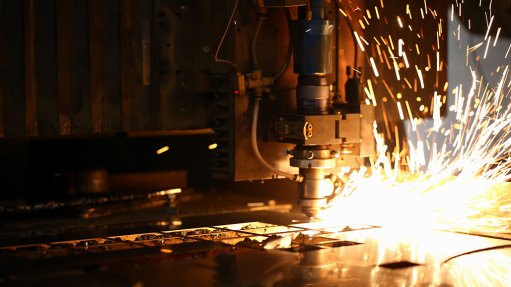Dry seal for wet applications to launch, suited to plants in water scarce African areas
The Type 2874 dry gas seal for pumps from mechanical seals manufacturer John Crane, which John Crane MD Aziz Sallie says is the first dry gas seal of this design to comply with API 682 and ISO 21049 performance capabilities for wet applications, will be launched this month.
He notes that many plants in Africa have limited access to water, making the Type 2874 an economical alternative, as 90% of the water traditionally used to lubricate and cool seals, is wasted by using it as the barrier fluid to lubricate and cool the seal faces.
John Crane external sales manager Poen Pienaar tells Engineering News that the Type 2874 is suitable for any wet pump application and it “does not require any liquid to lubricate and cool the faces of the seal, as there is no contact between the seal faces when in operation”.
He adds that the dry gas seal features spiral groove technology on the mating ring, combined with a carbon face to form the primary seal. On starting the pump, the gas barrier is pumped across the face of the seal generating pressure and a gas cushion preventing contact of the mating rings and subsequent heat generation. The seal is currently available in sizes from 35 mm to 100 mm for temperatures from –35 ºC to 260 ºC and pressures from vacuum to 41 barg.
The company is also launching the Type 3740 split seal this month, designed for easy installation on all pumps. This is especially cost-effective on horizontal split-case pumps as much of the ancillary equipment surround-ing the pump, such as the pump and bearing casings, as well as the transmission coupling, need to be removed when fitting standard mechanical seals. Owing to the size and weight of some of this equipment, cranes are required to move it, which is time consuming and costly.
“The Type 3740 split seal can be installed in 20 minutes, as it does not require the removal of major equipment or the alignment of the equipment, reducing downtime and, thereby, saving money,” says Sallie. The 3740 split seal is designed for pressures from vacuum to 21 barg and is available in sizes from 40 mm to 150 mm.
John Crane South Africa also manufactures packing, which Pienaar explains is used to seal rotating shafts on pumps, as well as valve-stem sealing for all industries.
Plan 53B-certified sealing systems are manufactured at John Crane’s Durban branch, in KwaZulu-Natal. These systems are used to support barrier liquid supply to double mechanical seals used to prevent hazardous or environmentally harmful products escaping into the atmosphere, explains Pienaar.
“Plan 53B is a pressurised barrier support system for double mechanical seals commonly used in the petrochemicals and oil and gas industries,” he adds.
Sallie says documentation and certification confirming the equipment is fit for the purpose it is designed for is supplied with every system built in the form of a data pack containing all design details and material certification as well as Authorised Inspection Authority certification. Without the data pack and certification, the equipment will not be installed, owing to the hazardous nature of the applications in which these sys-tems are designed to function and the strict regulations in place to ensure operator and environmental safety.
John Crane stocks more than R300-million in wet seals and spares for the pumping industry and more than R10-million in pack-ing stock. He notes that the company also stocks more than R10-million in base material stock used for Plan 53B sealing systems.
The company has four seal reliability contracts with oil refinery companies across South Africa. “Reliability contracts stipulate that companies pay John Crane a fixed monthly fee, as John Crane will replace a seal at its own cost, should it fail, for the duration of the contract,” Sallie explains, adding that this highlights John Crane’s commitment to providing reliable products.
He says a reliability contract enables com- panies to accurately budget for seal mainte-nance and replacement costs.
The company will extend one of the reliability contracts by July 2014 to include all the ancillary equipment surrounding pumps, Sallie adds.
John Crane supplies ancillary equip-ment, such as shims, laser alignment tools, mechanical seals, mechanical packing, seal support systems, bearings, bearing isolators, filtration systems and transmission couplings.
Meanwhile, the company launched a reliability department in July, which provides training for plant operators working on pumps.
Sallie notes that the John Crane reliability department will provide pumps training for a South African petrochemicals company this month. “Teaching an operator to efficiently operate a pump increases the reliability of pumps and mechanical seals,” he asserts.
“The reliability department has improved the mean time between failures on pumps at a plant, from 49 months to 68 months,” he notes, adding that John Crane personnel are qualified to manage every aspect of a pump and its ancillary equipment, not just seals.
Pienaar notes that the training typically takes one to three days, depending on the course content, and covers several aspects of mechanical seal reliability, such as equipment that can be used in conjunction with a seal to increase reliability.
Operators are trained to identify poten-tial problems on equipment, thereby limit-ing premature failure of equipment and improving reliability and reducing cost. Artisans are trained to perform failure analysis on seals and to compile an observa-tion report. This allows operators to recom-mend corrective measures to improve equipment reliability and reduce downtime.
Sallie says the training is geared towards identifying potential challenges before a failure occurs . “John Crane is working closely with the process industries reliability forums to help increase pump efficiency, while reducing downtime and costs, owing to equipment failure.”
An important factor in pump efficiency, he says, is ensuring that a pump runs at the performance curve for which it is designed. Further, the selection of the correct ancillary equipment – such as motors and gearboxes – supporting the pump is another important contributor to pump efficiency.
Sallie notes that, in 2008, John Crane devel- oped a programme called Interface, which records all data pertaining to pump equip-ment. The data is stored on John Crane’s server and is accessible to end-users over the Internet by accessing the website link.
“This software tracks reliability and root cause analysis and allows plant management staff to view performance data and causes of pump equipment failures,” he explains.
Pienaar notes that the company’s customers also have access to John Crane’s reliability data, which enables them to view their plant performance and status from anywhere in the world using the Internet.
Sallie notes that producing local content is an important theme across all South African industries. John Crane manufactures 80% of its products locally. “The company is being benchmarked by the Department of Trade and Industry, which could result in John Crane being a preferred supplier for projects allocated by the National Planning Commission.
“John Crane’s manufacturing plant is equipped to engineer, supply and commission end-users in the pumps industry with equip-ment within 24 hours,” he notes, adding that the facility currently runs two consecutive shifts, but, should demand increase, it can handle three consecutive shifts.
“The plant has been divided into three areas, allocated to six machining centres, manual lathes to produce minor hardware for mechanical seals and training of apprentices,” says Sallie.
As part of its skills development initiative, John Crane is actively involved in training and apprenticeship programmes. The training the company provides is certified through the Manufacturing, Engineering and Related Services Sector Education and Training Authority and people trained at John Crane are under no obligation to work for the company once they have completed and passed their final trade test, he notes.
John Crane South Africa acts as the service and distribution centre for key process plants across Africa. Four branches in Secunda, Sasolburg, Cape Town and Durban are equipped to provide their customers with a full repair and backup service at any time. The Johannesburg-based head office is the only branch with design and manufacturing capabilities.
John Crane’s headquarters are in Chicago, in the US. The company, which employs about 7 000 people globally and in 2012 recorded revenues totalling about £973-million, is the largest division of LSE-listed global technology company Smiths Group. Smiths Group is made up of five divisions: John Crane; specialist medical devices, consumables and equipment supplier Smiths Medical; threat and contraband detection manufacturer Smiths Detection; signal, power and microwave solutions provider Smiths Interconnect; and provider of engineered components that heat and move fluids and gases Flex-Tek. The group employs over 23 000 people and operates in over 50 countries.Article Enquiry
Email Article
Save Article
Feedback
To advertise email advertising@creamermedia.co.za or click here
Comments
Press Office
Announcements
What's On
Subscribe to improve your user experience...
Option 1 (equivalent of R125 a month):
Receive a weekly copy of Creamer Media's Engineering News & Mining Weekly magazine
(print copy for those in South Africa and e-magazine for those outside of South Africa)
Receive daily email newsletters
Access to full search results
Access archive of magazine back copies
Access to Projects in Progress
Access to ONE Research Report of your choice in PDF format
Option 2 (equivalent of R375 a month):
All benefits from Option 1
PLUS
Access to Creamer Media's Research Channel Africa for ALL Research Reports, in PDF format, on various industrial and mining sectors
including Electricity; Water; Energy Transition; Hydrogen; Roads, Rail and Ports; Coal; Gold; Platinum; Battery Metals; etc.
Already a subscriber?
Forgotten your password?
Receive weekly copy of Creamer Media's Engineering News & Mining Weekly magazine (print copy for those in South Africa and e-magazine for those outside of South Africa)
➕
Recieve daily email newsletters
➕
Access to full search results
➕
Access archive of magazine back copies
➕
Access to Projects in Progress
➕
Access to ONE Research Report of your choice in PDF format
RESEARCH CHANNEL AFRICA
R4500 (equivalent of R375 a month)
SUBSCRIBEAll benefits from Option 1
➕
Access to Creamer Media's Research Channel Africa for ALL Research Reports on various industrial and mining sectors, in PDF format, including on:
Electricity
➕
Water
➕
Energy Transition
➕
Hydrogen
➕
Roads, Rail and Ports
➕
Coal
➕
Gold
➕
Platinum
➕
Battery Metals
➕
etc.
Receive all benefits from Option 1 or Option 2 delivered to numerous people at your company
➕
Multiple User names and Passwords for simultaneous log-ins
➕
Intranet integration access to all in your organisation


















